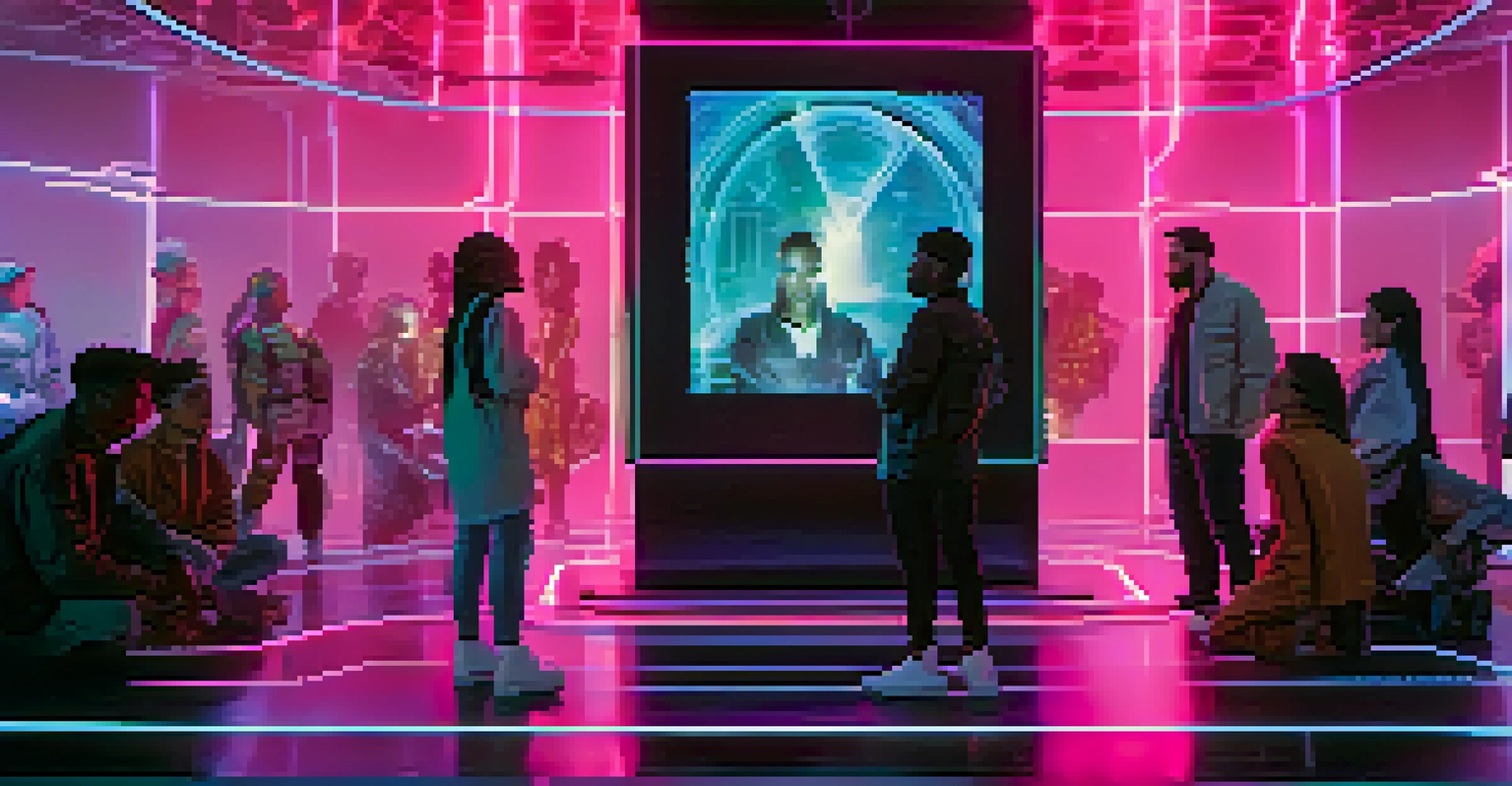Enhancing Narrative Depth with NFTs in Digital Media

Understanding NFTs: A Quick Primer for Digital Media
NFTs, or non-fungible tokens, represent unique digital assets verified on a blockchain. Unlike cryptocurrencies, which are interchangeable, each NFT has distinct properties that make it one-of-a-kind. This uniqueness allows creators to sell digital art, music, and other media in ways that were previously impossible, effectively changing the marketplace for digital content.
NFTs are a revolution in the way we think about ownership and provenance in digital media.
For instance, consider a digital artwork that an artist sells as an NFT. Buyers can own a verified piece of that artwork, complete with a digital certificate of authenticity, which adds value beyond just the visual experience. This ownership can enhance the narrative around the artwork, as collectors can share the story of their acquisition and what the piece means to them.
In this way, NFTs not only serve as a new medium for creators but also provide a tangible layer to storytelling. As we delve deeper into how NFTs can enhance narrative depth, it's essential to grasp this foundational concept of ownership and its significance in the digital realm.
Creating Unique Story Experiences with NFTs
NFTs enable creators to craft unique experiences that traditional media can't offer. By integrating NFTs into storytelling, artists and authors can provide their audience with exclusive content, such as behind-the-scenes footage or alternate endings. This interactivity invites engagement, allowing fans to feel like they're part of the story rather than just passive viewers.

For example, a filmmaker could release NFTs that grant holders access to special screenings or even the opportunity to influence plot twists. This not only enriches the narrative but also builds a community around shared experiences. Fans become invested in the outcome, enhancing their connection to the story and the creator.
NFTs Enhance Digital Ownership
NFTs provide unique ownership of digital assets, allowing creators to sell and authenticate their work in a way that was previously impossible.
As we explore this innovative approach, it becomes evident that NFTs can bridge the gap between creator and audience, fostering deeper emotional ties. This engagement can lead to a richer narrative experience, where the audience feels they have a stake in the storytelling process.
The Role of Scarcity in Digital Storytelling
One of the most compelling aspects of NFTs is their ability to create scarcity in digital media. In a world where digital content can be easily copied, NFTs introduce a sense of rarity and exclusivity. This scarcity can amplify the narrative by making certain elements more desirable, whether that's a limited-edition artwork or a one-of-a-kind music track.
The future of storytelling is not just in the narrative, but in the experience we create around it.
Think of it this way: if a musician releases a song as an NFT, and only a handful of copies are available, the value of each copy skyrockets. Fans who own these NFTs can share not just the music but also the story of their ownership, which adds another layer of meaning to the piece. This interplay of scarcity and storytelling can provoke deeper discussions and connections among fans.
By understanding and leveraging scarcity, creators can enhance the narrative depth of their work, turning simple digital content into coveted collectibles. This shift in perception can profoundly impact how audiences engage with stories and the creators behind them.
Building Communities Through NFT-Driven Narratives
NFTs can serve as a catalyst for community building around specific narratives. When fans invest in NFTs, they often become part of a larger community that shares their interests and passions. This sense of belonging can enhance the narrative experience, as members come together to discuss, share, and even collaborate on new stories.
For instance, a graphic novelist could sell NFTs that allow fans to contribute ideas for future story arcs. This collaborative approach not only deepens the narrative but also creates a vibrant community where fans feel valued and heard. Their contributions can shape the story, making it more personal and engaging for everyone involved.
Building Communities Through NFTs
NFTs foster community engagement by allowing fans to contribute ideas and collaborate on narratives, transforming storytelling into a shared experience.
As we see in this example, NFTs can transform storytelling from a solitary experience into a communal journey. This shift fosters a deeper connection not just to the narrative itself but also to the community that surrounds it, enriching the overall storytelling experience.
Enhancing Interactivity: Gamification of Storytelling
Gamification is another exciting aspect of incorporating NFTs into narratives. By adding game-like elements, creators can make the storytelling process more interactive and engaging. Users can earn NFTs by completing challenges or participating in story-related activities, which can unlock new content or experiences.
Take, for example, an interactive narrative where readers are given choices that influence the plot's direction. Those who make significant contributions could earn exclusive NFTs that allow them to access hidden chapters or character backstories. This level of interactivity deepens the narrative as readers become active participants in shaping the story.
As we explore this gamified approach, it's clear that NFTs can transform storytelling into a dynamic experience. This not only keeps audiences engaged but also allows for a more personalized narrative journey that resonates deeply with each individual.
NFTs as a Tool for Preservation of Digital Art and Stories
NFTs also play a crucial role in the preservation of digital art and stories. By minting an NFT, creators can ensure that their work is stored on the blockchain, making it resistant to loss or degradation over time. This preservation aspect is particularly important in an era where digital content can easily be erased or forgotten.
Consider a scenario where an artist creates an iconic digital piece that captures a significant moment in culture. By minting it as an NFT, not only does the artist secure ownership, but they also create a lasting record of that moment. Future generations can engage with this work, understanding its context and significance, thus enriching the overall narrative.
Ethical Considerations in NFTs
Creators must navigate copyright and environmental issues associated with NFTs to ensure responsible storytelling and fair compensation.
In this way, NFTs serve not just as a current medium for storytelling but also as a historical archive. They help maintain the integrity of digital narratives, ensuring that stories and art are preserved for years to come.
Navigating the Ethical Considerations of NFTs in Storytelling
With the rise of NFTs in digital media, ethical considerations also come into play. Creators must navigate issues such as copyright, ownership rights, and environmental concerns associated with blockchain technology. Understanding these nuances is crucial for responsible storytelling and ensuring that artists are fairly compensated for their work.
For example, a creator selling an NFT must ensure that they have the rights to the content they're tokenizing. Failure to do so can lead to legal disputes and undermine the trust between creators and their audiences. Moreover, the environmental impact of blockchain technology requires a thoughtful approach, as creators seek to balance innovation with sustainability.

As we delve into the ethical landscape of NFTs, it's important to highlight the need for transparency and responsibility. By addressing these concerns, creators can foster a positive narrative around NFTs that benefits both artists and audiences alike.
Looking Ahead: The Future of NFTs in Digital Storytelling
As we look to the future, the potential for NFTs in digital storytelling continues to expand. With ongoing technological advancements and a growing acceptance of blockchain technology, we can expect to see even more innovative ways to integrate NFTs into narratives. This evolution could redefine how we experience and interact with stories.
Imagine a world where your favorite author releases serialized stories as NFTs, with each episode unveiling new plot twists that readers can influence. This could lead to a more immersive storytelling experience, where narratives are not just consumed but actively participated in. The possibilities are limited only by our creativity.
In conclusion, the future of NFTs in digital storytelling is bright and full of promise. As creators embrace this technology, we are sure to witness narratives that are richer, more interactive, and deeply connected to their audiences, reshaping the landscape of digital media.